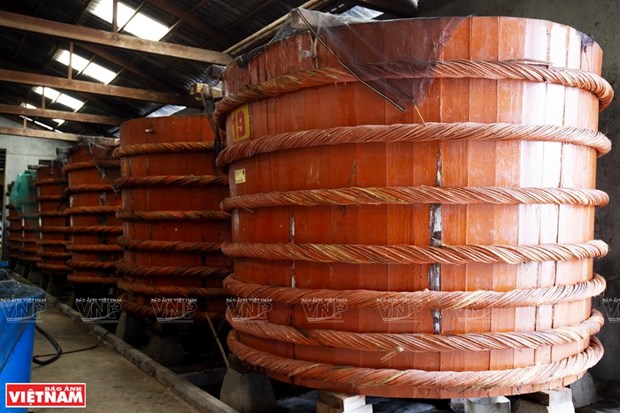Phu Quoc fish sauce making becomes national intangible cultural heritage
The Ministry of Culture, Sports and Tourism recognised the making of fish sauce on Phu Quoc island city in the Mekong Delta province of Kien Giang as a national intangible cultural heritage in late May, creating a driving force for local residents to maintain and uphold the essence of the traditional craft.
 |
| Phu Quoc fish sauce uses anchovy with high protein level as a key ingredient (Photo: VNA) |
Chairwoman of the Phu Quoc Fish Sauce Association Ho Kim Lien said Phu Quoc’s waters are home to a variety of seaweed and plankton that are major feed sources for anchovies - a key ingredient in its fish sauce.
The craft has existed in Phu Quoc for over 200 years ago. Local residents catch fresh anchovies and salt them before fermenting them in giant wooden barrels.
Fermenting them in wooden barrels is a feature of the traditional craft. The older the barrel is, the more durable it becomes and the better the quality of the fish sauce is.
The barrel has a wide mouth and is made from 55 planks of equal size: 2.2 metres long, 20cm wide, and 6cm thick. The diameter of the barrel mouth is about 3.2 metres and that of the bottom is some 2.6 metres. It is also strapped with green rattan.
Lien said the fish sauce is produced based on traditional methods, with the recipe being three parts anchovy and one salt, and the fermentation period lasts from 10 to 15 months. From the first to final layers, the fish sauce is divided into different types based on their protein levels. The final product has an amber colour and a slight aroma.
With support from the French Embassy in Ha Noi in 1998, the Ministry of Fisheries along with Kien Giang province prepared an application for geographical indication. On June 1, 2001, Phu Quoc fish sauce was the first product in Vietnam to secure such status.
In July 2013, the EU granted the “Phu Quoc” origin certificate to the Vietnamese fish sauce.
A month later, the Ministry of Industry and Trade handed over the certificate to representatives of the Phu Quoc island district People’s Committee and the Phu Quoc Fish Sauce Association and it has now become an attractive local tourism product.
Phu Quoc city is now home to around 100 fish sauce makers, mostly in Duong Dong and An Thoi wards. Between now and 2025, it will strive to produce 12 million litres of fish sauce each year on average.
According to Lien, a major difficulty for the industry is that some consumers cannot identify genuine Phu Quoc traditional fish sauce, leading to unstable prices. There is currently no planning for a Phu Quoc fish sauce craft village, so it has not yet become a tourist destination.
The Phu Quoc Fish Sauce Association, founded in October 2000 and with 53 members, will pay attention to developing fish sauce quality to continue promoting its trademark, she said.
The craft is also expected to seek UNESCO world intangible cultural heritage status, contributing to improving its brand value and promoting the image of Phu Quoc island city.
Source: VNA